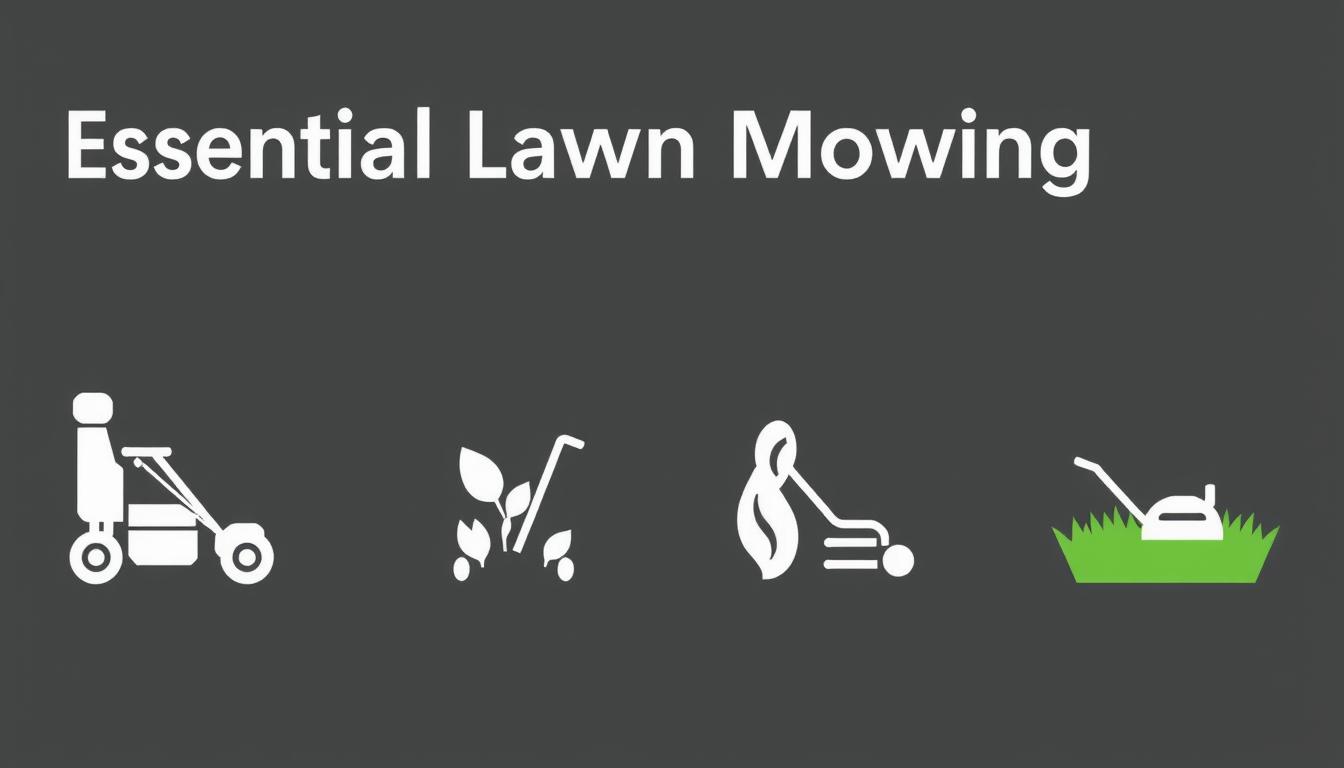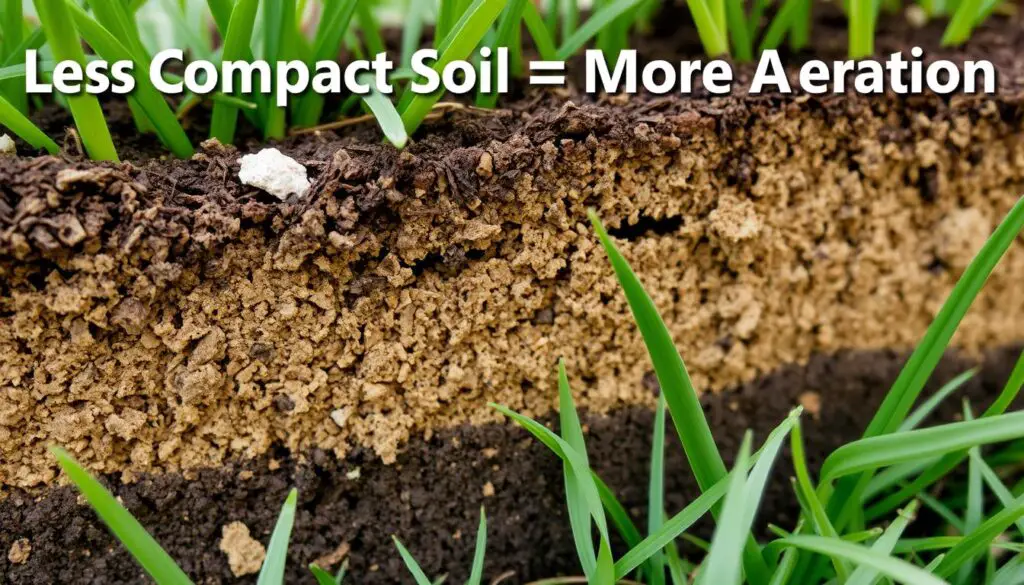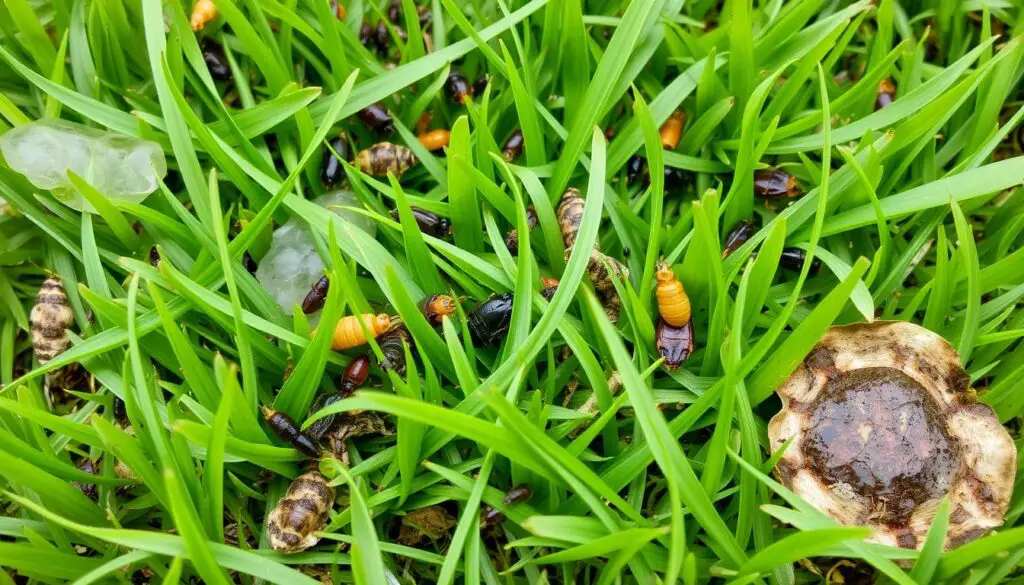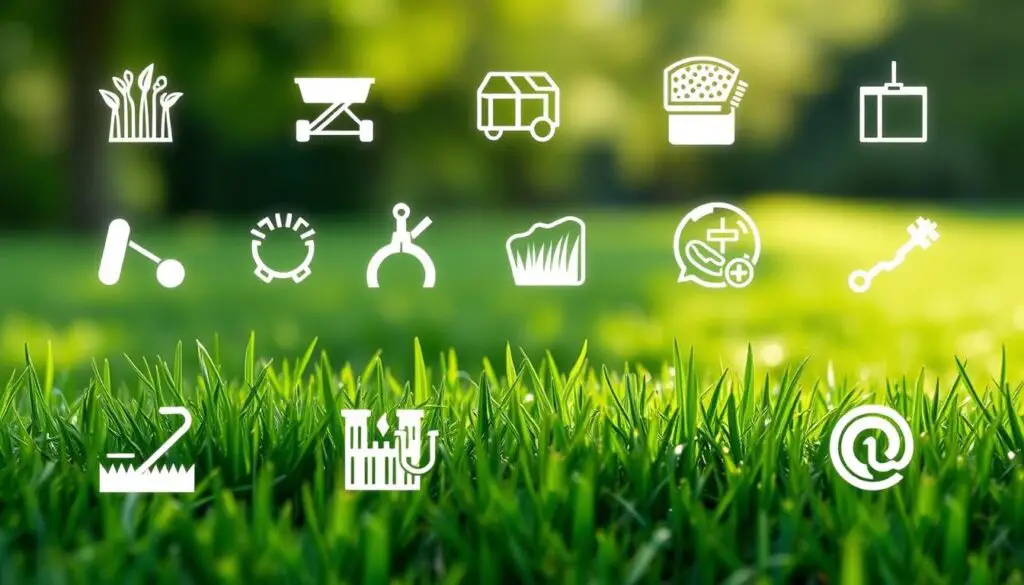Understanding Lawn Care Terminology A Glossary for Homeowners

Did you know over $1.5 million has been sponsored by the Illinois Turfgrass Foundation for local projects? Caring for a lawn in the United States means knowing many terms and services. This glossary covers key lawn care vocabulary, like soil, nutrients, pests, and maintenance.
By learning these terms, you can talk better with lawn care experts. You’ll also make smarter choices for a healthy lawn.
Key Takeaways
- Lawn care terminology covers many topics, including grass types, fertilizers, and weed control.
- Knowing these terms helps homeowners talk better with lawn care pros.
- Good lawn care means understanding soil, nutrients, and how to maintain it.
- Lawn care is key to keeping your property looking good and healthy.
- Keeping up with lawn care trends helps homeowners make better choices.
Essential Nutrients for Healthy Lawns
To keep your lawn looking great, it needs the right nutrients. Nitrogen, phosphorus, and potassium are key for a healthy lawn. Knowing how these nutrients work can help you create a beautiful outdoor space.
Nitrogen: Promotes Vigor and Green Color
Nitrogen is the main nutrient in lawn fertilizers. It helps grass grow fast and stay green. Getting the right amount of nitrogen is important for a beautiful lawn.
Phosphorus helps grass roots grow strong and deep. Potassium makes grass more resistant to cold and drought. It also helps grass absorb water and nutrients better.
Potassium is also used in winterizer treatments. These are applied in early winter to help grass survive cold weather. Knowing about lawn nutrients, nitrogen, phosphorus, and potassium helps ensure your lawn gets what it needs.
“Properly feeding your lawn with the right balance of essential nutrients is the foundation for a healthy, lush landscape.” – Sam Masser, author here and mower specialist
Using the right fertilizers at the right time can make your lawn stand out. With some knowledge and good lawn care, you can have a stunning lawn.
Soil Conditions and Management
The health and growth of a lawn depend a lot on the soil conditions. Soil can be either acidic or alkaline. Acidic soils can slow down grass growth, while alkaline soils can also be a problem. Another issue is soil compaction, which stops air, water, and nutrients from reaching the roots.
Regular core aeration helps solve soil compaction. It lets the roots grow better and makes the lawn stronger.
Acidic vs. Alkaline Soils
Soil that’s too acidic can hurt grass growth. The best pH for grass is between 6 and 7. If the soil is too alkaline, it can also slow down grass growth.
To fix these issues, you might need to add lime. Adding organic matter to clay soil is better than sand. It helps keep water and nutrients in the soil.
Compaction and Core Aeration
Soil that’s too compact can harm grass health. Aeration helps by improving drainage and root growth. Core aeration makes holes in the soil for better nutrient flow.
This makes the lawn look and feel better overall.
| Soil Type | Characteristics |
|---|---|
| Clay Loam | More clay and equal parts of sand and silt |
| Sandy Loam | More sand and equal parts of clay and silt |
| Loam | Equal parts of clay, sand, and silt |

“In a study on lawn care topics, 65% of respondents noted that aeration is essential to address soil compaction issues and improve the oxygen, nutrient, and water flow in the ground.” – Richard, ecology specialist
Weed Control Strategies
Weeds can quickly ruin your lawn’s health and look. To fight them, you need a solid weed control plan. This plan should include using pre-emergent and post-emergent herbicides to tackle weeds at different times.
Pre-Emergent Herbicides
Pre-emergent herbicides stop weed seeds from growing before they even start. They work best against annual weeds like crabgrass and dandelions in early spring. Applying these herbicides on time can greatly cut down weed growth in your lawn.
Post-Emergent Herbicides
For weeds that have already grown, post-emergent herbicides are the answer. These treatments target and kill weeds, whether they’re grassy or broadleaf. Using post-emergent herbicides carefully helps remove weeds without harming your grass.
Using both pre-emergent and post-emergent herbicides is vital for a weed-free lawn. Regular checks, timely applications, and follow-up are essential for success. With the right approach, you can restore your lawn to its former beauty.
“Weeds can compete with desired flora for nutrients, water, and sunlight, making it essential to address them promptly and effectively.” – Laura, lawn health enthusiast
Common Lawn Pests and Diseases
Keeping your lawn healthy means watching out for pests and diseases. Grubs, Japanese beetles, and fungal infections like leaf blight can harm your grass. Knowing these common problems is the first step to fixing them.
Lawn Pests
Grubs, the young stage of beetles like Japanese beetles, can damage your lawn. They eat grass roots, causing dead patches. Other pests like chinch bugs, sod webworms, and armyworms also harm your lawn by eating it.
Lawn Diseases
Fungal diseases like leaf spot and lawn blight can hurt your lawn’s health and look. These diseases need certain conditions to grow, affecting cool-season and warm-season grasses. Spotting the signs early and fixing the cause is key to a healthy lawn.
| Lawn Pest/Disease | Affected Grass Types | Key Characteristics |
|---|---|---|
| Leaf Blight | Kentucky Bluegrass, Tall Fescue, Perennial Ryegrass | Caused by fungal pathogens, leading to discoloration and dieback of leaf blades |
| Gray Leaf Spot | Bermuda, Zoysia, St. Augustine, Tall Fescue | Fungal disease that causes gray or tan lesions on leaf blades |
| Leaf Spot and Melting Out | Cool-season and Warm-season Grasses | Characterized by circular, purplish-brown spots on leaves, often leading to thinning and dieback of the lawn |
| Necrotic Ring Spot | Kentucky Bluegrass, Perennial Ryegrass, Fine Fescue | Fungal disease that creates circular, dead patches in the lawn |
| Grubs | All Turfgrass Types | Larvae of beetles that feed on grass roots, causing dead patches and thinning |
| Chinch Bugs | All Turfgrass Types | Suck plant juices from grass blades, leading to yellowing and thinning of the lawn |
Knowing about common lawn pests and diseases helps homeowners prevent and fix problems. This keeps your lawn healthy and free from issues.

Overseeding and Lawn Renovation
Keeping your lawn healthy often means using techniques like overseeding and lawn renovation. These methods can make your lawn look new again. They help with thin spots, weeds, or damage from drought or pests.
Overseeding means spreading grass seed over your lawn to fill in bare spots. It makes your lawn look better and stronger. The best time to do this is from mid-August to mid-September. The soil is warm, and the nights are cool, which helps the seeds grow fast.
Lawn renovation is more serious. It might include dethatching, aeration, and reseeding for a new lawn. It’s great for fixing badly damaged or weed-filled lawns.
When overseeding, making sure the seed touches the soil is key. You can do this with core aeration or vertical mowing. Also, mowing your lawn to 1½ to 2 inches helps the new seed grow better.
After overseeding, water your lawn often but lightly. This keeps the seedbed moist and helps the seeds grow. About 6 weeks after the seeds germinate, fertilize your lawn with 1 pound of actual nitrogen per 1,000 square feet.
Whether you overseed or do a full lawn renovation, these steps can make your lawn beautiful. You’ll enjoy your outdoor space for many years.
Mowing Techniques and Best Practices
Proper lawn mowing is key to a healthy outdoor space. Knowing the right mowing height, frequency, and patterns is crucial. As a homeowner, I’ve found that following best practices keeps my grass looking great.
The mowing height depends on the grass type. For cool-season grasses, like those in northern areas, keep it between 2 1⁄2 to 3 1⁄2 inches. In summer, I raise it to 3 1⁄2 to 4 inches to help it stay moist and cool.
How often you mow matters too. I try to mow regularly, cutting no more than one-third of the grass at a time. Sharpening my mower blades once or twice a year also helps for a clean cut.
- Maintain the correct mowing height for your grass type, typically between 2 1⁄2 to 4 inches.
- Mow regularly, cutting no more than one-third of the grass blades at a time.
- Sharpen mower blades 1 to 2 times per year to ensure a clean cut.
- Change the mowing direction with each pass to encourage straight, healthy growth.
- Avoid scalping the edges of the lawn, as this can create conditions favorable for crabgrass.
By sticking to these mowing techniques, I’ve kept my lawn lush and healthy. Proper lawn mowing, mowing height, mowing frequency, and mowing patterns are essential. They help my lawn look great and stay healthy for years.

“Proper lawn mowing is the foundation of a beautiful, thriving outdoor space. By following best practices, you can ensure your grass remains healthy and vibrant for years to come.”
Lawn Care Terms
As a homeowner, knowing lawn care terms is key. It helps you talk to pros and make smart lawn care choices. This glossary covers grass types, soil, fertilizers, weed control, and pests. Learning these lawn care vocabulary terms will help you get the green lawn you want.
Grass Types and Characteristics
- Annual Grasses – These plants live for one year and are great for quick lawn color.
- Bermuda Grass – It grows fast and spreads well, making it popular for sunny spots.
- Kentucky Bluegrass – This cool-season grass does well in sun and shade, offering great color and texture.
- Carpetgrass – It’s dense and grows in damp, shady areas, perfect for wet spots.
- Centipedegrass – Slow-growing and likes sandy soil, but can’t handle cold winters.
Soil Conditions and pH
Soil pH is vital for your lawn’s health. Acidic soil is common in wet areas, while alkaline soil is found in dry, clay-rich soils.
Lawn Care Practices
- Overseeding – Spreading seed to thicken and improve your lawn’s look.
- Aeration – Making holes in the soil to improve air, water, and nutrient flow.
- Mulching – Leaving clippings to decompose and enrich the soil, a green way to care for your lawn.
Learning this lawn care glossary boosts your knowledge. It helps you make better choices and talk to lawn care experts. Knowing these lawn care vocabulary terms is a big step towards a beautiful, healthy lawn.

Sustainable Lawn Care Practices
More homeowners are now choosing sustainable lawn care to keep their yards beautiful and healthy. They do this while trying to reduce their impact on the environment. The main steps are using organic fertilizers and integrated pest management (IPM).
Organic Fertilizers
Traditional synthetic fertilizers can harm the environment. On the other hand, organic fertilizers like compost and manure are better. They give grass the nutrients it needs without harming the planet.
These natural products also improve soil quality. They help grow beneficial microbes and increase organic matter in the soil.
Integrated Pest Management (IPM)
Integrated Pest Management (IPM) is a green way to care for lawns. It focuses on preventing and controlling pests naturally, not just using pesticides. This method looks at the reasons behind pest problems and uses different ways to solve them.
By choosing sustainable lawn care, homeowners can have a beautiful lawn and help the environment. Using organic fertilizers and IPM makes a big difference. It helps save natural resources and keeps local ecosystems healthy.
“Sustainable lawn care is not just about having a beautiful yard – it’s about making choices that protect the environment and preserve the health of our communities.”
Irrigation and Water Management
Keeping your lawn green and healthy needs careful water use. As a homeowner, knowing how to water your lawn is key. You must think about the grass type, soil, and local weather.
Drought-tolerant grasses like Bermuda grass or buffalo grass use less water. They’re perfect for areas where water is scarce. These grasses handle hot, dry weather well.
Watering deeply but less often is better than shallow, frequent watering. This method helps roots grow deeper. Watering in the early morning or evening also saves water by reducing evaporation.
- Use smart irrigation systems that adjust based on soil moisture and weather.
- Install a rain sensor or moisture sensor to avoid watering when it’s wet.
- Choose drip irrigation or soaker hoses to water roots directly, cutting down on runoff and evaporation.
By using water-efficient lawn irrigation, you can keep your lawn green and save water. With the right methods, your lawn will thrive even in tough weather.
Lawn Care Tools and Equipment
Keeping your lawn looking great is all about the right tools. From mowers to edgers, each tool is key to a beautiful lawn. Knowing how to use these lawn care tools is crucial for a great outdoor space.
A good lawn mower is a must-have. You can choose from walk-behind mowers for $3,000 to $6,000 or zero-turn mowers for $3,000 to $16,000. The right mower makes a big difference in your lawn’s look and health.
Other important tools include string trimmers, hedge trimmers, edgers, and leaf blowers. Prices vary from $300 to over $1,000. But, they’re worth it for a perfect lawn.
For a healthy lawn, you’ll also need aerators, dethatchers, and lawn spreaders. Aerators cost $100 to $400 and help with soil health. Dethatchers and spreaders, also $100 to $400, ensure even treatment distribution.
The right tools are essential for lawn care. By learning about lawn care tools and investing in quality, you can have the lawn of your dreams. It will also boost your property’s curb appeal.
| Tool | Price Range |
|---|---|
| Walk-Behind Push Mower | $3,000 – $6,000+ |
| Zero-Turn Riding Mower | $3,000 – $16,000 |
| String Trimmer | $300 – $500+ |
| Hedge Trimmer | Around $500 |
| Handheld Edger | $300 – $600 |
| Walk-Behind Edger | Up to $1,000 |
| Handheld Blower | $300 – $400 |
| Backpack Blower | Around $700 |
| Lawn Spreader | $100 – $400 |
| Tow-Behind Sprayer | $200 – $1,200 |
The tools you need depend on your lawn’s size and type. Choose quality tools for lasting performance and a beautiful lawn all year.
Hiring Professional Lawn Care Services
For homeowners who don’t want to deal with lawn care, hiring professional lawn care services is a great option. These companies have trained experts who can handle everything from mowing to pest control. This way, homeowners can enjoy a well-kept lawn without the effort.
The cost of lawn care services varies, but most homeowners pay around $380 for fertilization. The price for overseeding or aeration and overseeding is about 6lbs/1000sqft. This makes it easy to budget for lawn care.
Even though prices might change due to unexpected issues, professional services offer peace of mind. They ensure your lawn stays healthy and looks great, all without your effort.
FAQ
What are the three primary macronutrients for lawn health?
How can soil conditions affect a lawn’s health?
What is the difference between pre-emergent and post-emergent herbicides?
What are some common lawn pests and diseases that homeowners should be aware of?
What is the difference between overseeding and lawn renovation?
What are some best practices for mowing a lawn?
What are some sustainable lawn care practices?
How can homeowners effectively manage lawn irrigation and water usage?
What types of lawn care tools and equipment are essential for homeowners?
When should homeowners consider hiring professional lawn care services?
Source Links
- https://outdoorexpressionslandscaping.com/blog/lawn-care-101-a-glossary-of-what-you-need-to-know/index.php
- https://lehighvalleylawn.com/blog/what-nutrients-are-in-lawn-fertilizers-how-do-they-help-your-grass
- https://www.lawndoctor.com/boston-ma/lawn_care_glossary/
- https://theturfgrassgroup.com/turf-care/soil-management-for-your-lawn/
- https://erbertlawns.com/lawn-care-tips/managing-weeds-in-large-areas/
- https://nextlevelturf.net/understanding-the-role-of-fertilization-weed-and-insect-control-in-lawn-care/
- https://weedman.com/blog/common-lawn-diseases
- https://www.gardentech.com/blog/pest-id-and-prevention/how-to-detect-and-treat-common-lawn-pests
- https://limbwalkertree.com/blog/mowing-basics-how-to-maintain-healthy-lawn
- https://www.lawnstarter.com/blog/lawn-care-2/glossary-of-common-lawn-and-garden-terms/
- https://iwanttomowyourlawn.com/the-role-of-no-mow-may-in-encouraging-sustainable-lawn-care-practices/
- https://scotts.com/en-us/seasonal-tips/smart-ways-to-maintain-an-eco-friendly-lawn.html
- https://www.irrigation.org/IA/FileUploads/IA/Resources/IA_Glossary_of_Terms_July2017.pdf
- https://www.lawnnibbler.com/glossary-of-landscaping-terms
- https://www.fbfs.com/learning-center/new-homeowners-here-s-the-lawn-care-essentials-you-need

